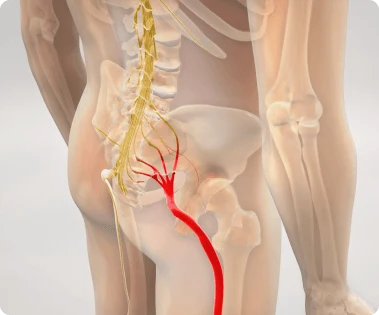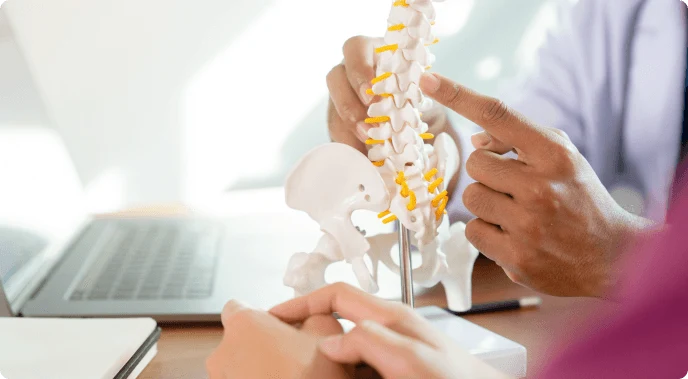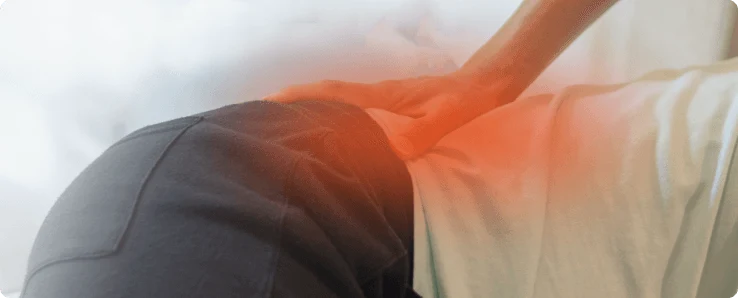
Conditions
Sciatica in Singapore

Dr Thor Timothy
Consultant Pain Specialist & Anaesthesiologist
MBBS (S'pore), MMed (Anaesthesiology), FFPMANZCA (USA), EDPM (Europe),FAM (S'pore)
What Is Sciatica?
Sciatica is a condition characterized by pain that radiates along the path of the sciatic nerve, which runs from the lower back through the hips and buttocks and down each leg. It occurs when the sciatic nerve is compressed, irritated, or inflamed.
Sciatica is not a disease itself but rather a symptom of an underlying medical issue affecting the sciatic nerve. The pain can range from mild discomfort to severe, debilitating pain that affects daily activities and mobility.

What Are the Types Of Sciatica?
Sciatica can be categorized into different types based on its duration, cause, and severity:
1.
Acute Sciatica – Lasts for a few days to a few weeks and often resolves with conservative treatment like rest, pain medication, and physiotherapy.
2.
Chronic Sciatica – Persists for more than 12 weeks and may require more advanced treatment, such as injections or surgery.
3.
Alternating Sciatica – A rare condition where pain occurs alternately in both legs due to spinal or sacroiliac joint dysfunction.
4.
Bilateral Sciatica – Affects both legs simultaneously, often due to severe spinal conditions like cauda equina syndrome or spinal stenosis.

What Causes Sciatica?
Several conditions can lead to sciatic nerve irritation or compression, including:
Herniated Disc – When the soft inner portion of a spinal disc pushes through its outer layer, it can press on the sciatic nerve.
Spinal Stenosis – Narrowing of the spinal canal puts pressure on the nerves, leading to sciatic pain.
Piriformis Syndrome – Tightening or spasms of the piriformis muscle in the buttocks can compress the sciatic nerve.
Degenerative Disc Disease – Wear and tear of spinal discs can contribute to sciatic nerve irritation.
Spondylolisthesis – When one vertebra slips forward over another, it can pinch the sciatic nerve.
Trauma or Injury – Accidents, falls, or sports injuries can lead to nerve compression.
Tumors or Infections – Though rare, tumors or infections near the spine may put pressure on the sciatic nerve.
Signs And Symptoms Of Sciatica

Sciatica usually presents with various symptoms, depending on the severity of nerve compression. Common symptoms include:
Sharp, burning, or shooting pain in the lower back, buttocks, and legs.
Numbness or tingling sensations in the affected leg.
Muscle weakness in the leg or foot.
Pain that worsens with prolonged sitting or standing.
Difficulty walking or controlling leg movements.
Pain that radiates down the leg, often following the sciatic nerve’s path.
Risk Factors For Sciatica
Certain factors increase the likelihood of developing sciatica, including:
Age – Degenerative spinal changes are more common with aging.
Obesity – Excess weight puts added pressure on the spine and nerves.
Sedentary Lifestyle – Prolonged sitting weakens core muscles, increasing strain on the lower back.
Occupation – Jobs involving heavy lifting, prolonged sitting, or repetitive twisting motions increase the risk.
Diabetes – Can lead to nerve damage, increasing susceptibility to sciatic nerve irritation.
Smoking – Reduces blood flow to spinal tissues, affecting nerve health.
Poor Posture – Misalignment and improper movement patterns contribute to nerve compression.


How Is Sciatica Diagnosed?
A doctor may use various methods to diagnose sciatica and its underlying cause:
Medical History Assessment – Understanding symptoms, duration, and potential triggers.
Physical Examination – Testing reflexes, muscle strength, and movement limitations.
Straight Leg Raise Test – Lifting the affected leg while lying down to reproduce sciatic pain.
Imaging Tests – X-rays, MRI, or CT scans provide detailed views of the spine and nerves.
Electromyography (EMG) – Measures electrical activity in muscles to assess nerve function.
How Is Sciatica Treated & How To Manage The Pain?
The treatment approach will depend on the severity and cause of sciatica.
Conservative Treatments
For mild to moderate cases, initial treatments include:
Rest and Activity Modification – Avoiding aggravating movements while staying lightly active.
Physiotherapy – Strengthening core muscles and improving flexibility.
Pain Medications – Over-the-counter NSAIDs (ibuprofen, naproxen) or prescribed medications for stronger relief.
Cold and Heat Therapy – Applying ice packs or heat pads to reduce pain and inflammation.
Postural Corrections – Ergonomic chairs and proper sitting habits can alleviate pressure on the sciatic nerve.


Can Sciatica Be Prevented?
While not all cases can be prevented, certain lifestyle habits can lower the risk:
Maintaining good posture and spinal alignment
Engaging in regular exercise, focusing on core strength and flexibility
Using proper lifting techniques
Avoiding prolonged sitting and taking frequent movement breaks
Managing weight to reduce spinal strain
When To Seek Medical Attention For Sciatica?
Seek immediate medical care if you experience:
Severe pain that does not improve with rest
Weakness, numbness, or difficulty moving your leg
Loss of bladder or bowel control
Pain after a significant injury or trauma
Symptoms persisting for more than a few weeks despite treatment

GET IN TOUCH
Contact Us Today
For more information about our services, or to make an appointment, please reach out to us. We will get back to you as soon as possible.

Frequently Asked Questions
Yes, but it is rare. Bilateral sciatica often results from severe spinal conditions like spinal stenosis and requires urgent medical evaluation.

Sciatica Specialist in Singapore
Dr Thor Timothy
Consultant Pain Specialist & Anaesthesiologist
MBBS (S’pore), MMed (Anaesthesiology), FFPMANZCA, FIPP (USA), EDPM (Europe), FAM (S’pore)
MBBS (S’pore), MMed (Anaesthesiology), FFPMANZCA, FIPP (USA), EDPM (Europe), FAM (S’pore)
Accreditations & Qualifications:
Bachelor of Medicine, Bachelor of Surgery (Singapore)
Master of Medicine in Anaesthesiology (Singapore)
Fellow of the Faculty of Pain Medicine, Australian & New Zealand College of Anaesthetists
Fellow of Interventional Pain Practice (USA)
European Diploma in Pain Medicine
Fellow of the Academy of Medicine, Singapore
Dr Thor Timothy is a consultant anaesthesiologist and pain specialist in Singapore with nearly 20 years of medical experience, including over a decade in pain medicine. Formerly the Director of Acute Pain Services at Singapore General Hospital, he is experienced in treating sciatica and other nerve-related back conditions, working with patients to ease discomfort and support long-term recovery. He holds multiple international pain medicine qualifications and is dedicated to delivering compassionate, multidisciplinary care tailored to each patient’s needs.
